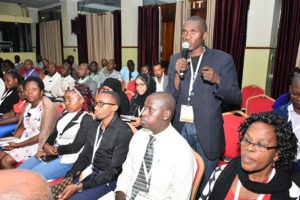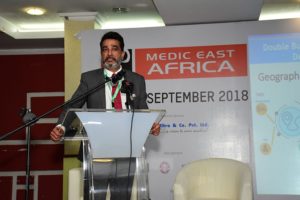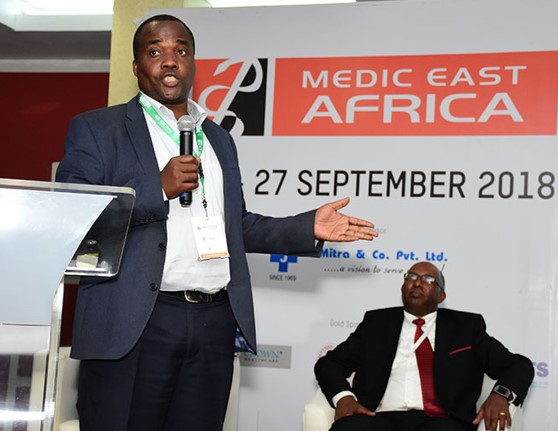6th Healthcare Management Conference
The 6th annual Healthcare Management conference, organized by Medic East Africa, took place at Kenyatta International Conference Centre ,Nairobi, Kenya from 25th to 27th September 2018.The conference had three different themes for each of the three days. The first day’s theme was “From vision to Action – Reinforcing Healthcare Systems in East Africa, the second day was “The Role of Clinical Officers in the Implementation of Universal Health Coverage” and the third day’s theme was “Quality and Access under Universal Health Coverage”. The objective of the forum was to drive the region towards a health leadership infrastructure that is focused on perfomance and is held accountable for delivering on specific health system goals.

The conference brought together over 150 exhibitors from 18 countries. The first day conference was moderated by Dr. Amit N. Thakker, Chairman, Kenya Healthcare Federation. In his presentation, he emphasized that the key barrier to reinforcing healthcare systems in east Africa are; geographical and financial. Dr. Thakker informed the attendees that over 85% of Kenya population do not have any form of a cover and rely on out of pocket. 50% of the population do not have an access to primary healthcare and this set back results from poverty. He called upon all healthcare workers in attendance to come out strongly in health advocacy because unfavorable health outcomes such as maternal mortality are increasingly becoming a daily occurrence. Dr. Thakker further urged the attendees to capitalize technology, which is in itself revolutionizing daily.
“We need to adopt auxiliary health workers and also strongly recognize community health workers for the big role they play in health. The ministry of health should have considered hiring the specialists that we don’t have instead of employing what we already have because this doesn’t help in filling the identified gaps in the workforce. The BIG 4 Agenda is supposed to ensure creation of job opportunities and 5% of the jobs are expected to come from the health sector. Therefore I call upon the public and private health sector to operate in harmony to see great job creation and ensure good service delivery.” Dr. Amit Thakker, Chairman ,Kenya Healthcare Federation.
Dr. Andrew Mulwa CEC-Health, Makueni County informed the attendees that some of the challenges in the county level towards achieving Universal Health Coverage are: lack of healthcare workers i.e. the recruitment and retention of human resources for health is very low. This is because most of the specialists that are required in the counties, are mostly concentrated in the urban areas. Finance is an important factor affecting access to quality healthcare and is challenge because most of the population does not have a formal employment therefore cannot purchase or contribute to medical cover plans. This leads to over reliance on out of pocket expenditure. He however added that recruitment and retention of the health workers should match the county’s economical abilities.


Dr. Janet Muriuki, Deputy Chief of Party/ Technical Director – Intrahealth International was in attendance and said “We need to motivate the health workers, to help in reducing immigration. Assessing the reason for immigration, creating a favorable environment for them to work and giving them a good remuneration will also help in retaining the health workers. However, there is low distribution of health workers where majority are concentrated in the urban areas. Question is, are we taking training where it is needed? Are the specialist deployed where they are needed? This should be the initial stage in gap analysis. Technology should be a vital tool in this .This is because it can display the gaps in the human resources and distribution of health workers and track the training of health workers i.e. who needs long term training and who needs short term training. Therefore it’s important to deploy specialist where there is deficiency and not where there is a surplus.” She emphasized that the health sector needs to employ workers who are fit for purpose and the health workers should ensure they are safe in their working environment. This would serve as one of the solutions for curbing immigration of health workers. According to world health organization(WHO),the ratio of health workers to the population per county should be 23:10,000 in Kenya whereas the current ratio is still low as we stand at 13:10,000. Dr. Muriuki noted that the counties with highest health workers deficiency are Isiolo and Wajir.
Ms. Faith Muigai, Regional Director, SafeCare, Pharm Access Foundation reiterated that there is need to need to shift attitude and create a good environment for patient care. We also have to change the narrative if we want to see good service delivery. However, she noted that there is poor or lack of infrastructure to enhance this. There is no independent body that checks the health workers performance thus there is no competition that would drive quality of service delivery. Ms. Faith said that more health facilities should be accredited and the accreditation system need not be a pass or fail model but one of incremental growth. In conclusion, Ms. Faith mentioned that data is required to drive transparency and accountability, that there is need to leverage on public private partnership so as to drive the quality agenda, and finally that there is need to invest in proactive and responsive versus reactive solutions.
Some of the major concerns that were raised from the audience were: there should be an assessment carried out on why there is poor distribution of health workers and even lots of immigration observed among the health workers and come up with a solution. There should also be a safe working environment for the health workers because some of the equipment and medication used exposes them to the dangers of contracting infections or even developing other health conditions. There was a recommendation that the health workers should be trained on disaster management even as we assess the training needs in the healthcare industry. Participants expressed unanimous consensus that there should be capacity building among the leaders to enhance accountability on financial management and on performance of healthcare workers. The policies created should also speak to each other.
The 6th annual Healthcare Management conference was a success bringing together a wide representation of stakeholders. The presenters provided key insights into the challenges and opportunities in the healthcare industry while the audience contributed engaging and thoughtful questions and remarks. If these ideas were implemented, we would expect to see the healthcare industry change for the good of all Kenyans! We look forward to the next conference
